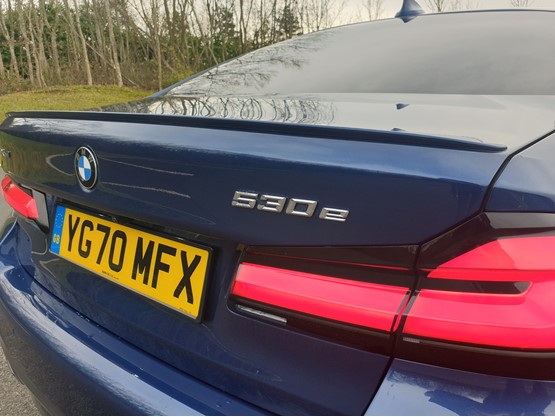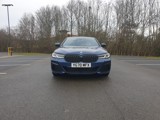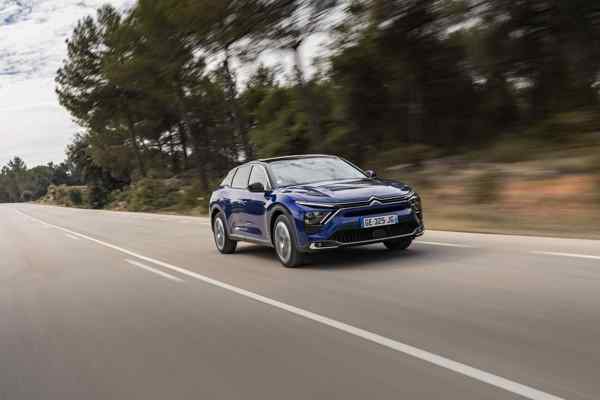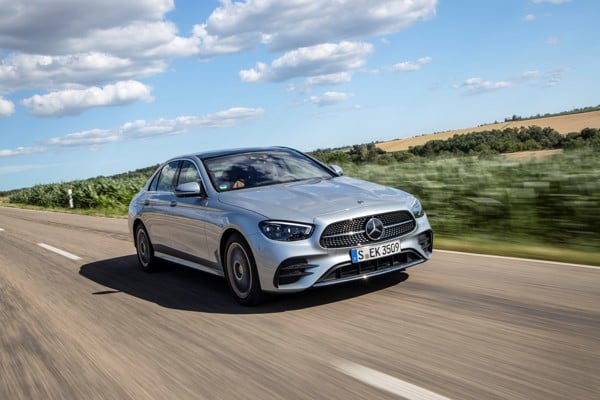Review
We’re changing tack for our farewell review of the BMW 530e plug-in hybrid. Many of our previous reviews have focused on the electric range, fuel performance and related costs, often comparing the car to its diesel or petrol alternatives.
That’s understandable, as the driver choice will often be between the internal combustion engine model and the PHEV, rather than a comparison of plug-in versus rival plug-in. We tested the 520d three years ago, although our current car was updated without fanfare a year ago with a larger 12.3-inch infotainment screen and mild refresh of the headlights and grille.
In addition, the plug-in version gained xDrive (BMW’s all-wheel drive system with intelligent Dynamic Stability Control) and a Touring derivative.
For our farewell, we’re going to ignore the engine and focus on our other likes (and the odd quibble).
The 5 Series is one of BMW’s best-looking models, with swooping roofline, sleek body lines and slimline headlights. Our car, dressed in ‘Phytonic Blue’ with black radiator grille, also presents a far more imposing sight that its chrome siblings.
The interior is ergonomic and high quality, with comfortable seats and supportive head rests, plenty of elbow and head space, premium materials, trendy ambient lighting in a rainbow choice of colours, and stylish layout with the right blend of design and function.
However, the lines on the satnav aren’t the easiest to distinguish – the green route line can sometimes blend in with other roads. However, the excellent head up display also provides directions, as does the centre of the binocle between speedo and rev counter so it’s difficult to go wrong.
Another irksome element is the car’s desire to reset its driving mode after every journey: once we’ve selected Adaptive, could it stay in that mode perchance?
There’s no compromise on luggage space, with the PHEV’s charging lead stowed away in a compartment under the boot floor, retaining the standard model’s 530 litres capacity.
In summary: the 5 Series is our pick of the executive cars from both a fleet and company car driver perspective – a view underlined by retaining its crown in the 2021 Fleet News Awards. The PHEV is the pick of the engines from a tax point of view but needs the right journey profile to maximise its efficiency.
Long-distance economy a "pleasant surprise"
It’s another efficiency test this month as a bank holiday weekend trip offered the first opportunity to measure the fuel consumption of the BMW 530e on an extended journey.
Previously, we’ve commented on the need for a journey of 10-plus miles to get the most out of the electric range; short two-to-three-mile trips rapidly drain the battery. But what about a 306-mile round trip to Gloucestershire with a full charge at the start of the journey, but no top-ups afterwards?
It sounds a recipe for disaster given all the claims about PHEVs being extremely inefficient when running solely on petrol. However, the 5 Series was a pleasant surprise.
With sat-nav engaged and Adaptive drive mode selected, which allows the car to automatically adjust accelerator sensitivity, gear shifts, steering sharpness and damper firmness based on driving and journey conditions, and the usual rules around keeping to speed limits, but not trying too hard to be ultra-efficient, the results were impressive.
Refilling at the end of the round trip produced figures of 54mpg, or with the 34 miles of electric range subtracted, 49mpg. From a 2.0-litre petrol, weighing in at 2,505kg, this is an incredible performance, putting the equivalent 2.0i Mild Hybrid 5 Series – a relative lightweight at 2,285kg – in the shade at 42.2mpg.
Used in the Adaptive/Hybrid mode, the car feeds in the electricity at optimum times – at my destination, 153 miles in, it still had six miles of electric range left on the trip computer.
I’ve been critical previously about plug-in hybrids; why spend almost four hours charging to get 30-plus miles of range when you can spend a couple more hours getting close to 200 miles on a full-electric.
However, the 530e is more flexible than originally thought, offering efficiency on journeys from 10 miles to 300, although peaking at around 150. I only wish I’d checked the fuel consumption at that point as the majority of the return journey was on petrol only.
Its only shortcoming is on the short trips.
Do driving modes make a difference?
Hybrid or electric: which driving mode offers lower fuel consumption and, therefore, fewest CO2 emissions on the 530e plug-in hybrid?
A series of 12-mile commutes in recent weeks for Fleet News Awards judging presented the ideal opportunity to test both modes.
First electric. The journey to work consists of A and B roads, with speeds ranging from 30mph-to-70mph. Weather conditions were fine with no use of the air-con or seat and steering wheel heaters. With speed having a significant impact on range, I’d expected the dual carriageway portion to sap the charge, but the on-board computer suggested that, once up to speed, the drain on the battery was low.
The 12-mile journey used exactly 12 miles of range – although it was notable (mentioned in previous tests) that during the first mile or so, the range slumped by three miles. PHEVs need journeys of 10-plus miles to show their true abilities.

Now, what about hybrid? This was a surprise. In this mode, the same commute used just seven miles of electric charge, yet the petrol range only dipped by one or two miles resulting in combined use of just eight-to-nine miles for a 12-mile journey.
It’s BMW witchcraft!
Managed by the on-board computer, Hybrid selects the best combination of electric and petrol depending on conditions and driving behaviour to deliver optimal performance, fuel consumption and comfort. My experiences suggest it works.
The 530e also has a two other modes: Sport, which tightens the steering, makes the throttle more responsible and ratchets up the gear shift, and Adaptive, which automatically adapts to the driving style and route (via sat-nav) to provide a more sporty or comfort set up. Both have a noticeable impact n the car’s performance.
Something that works less well and is starting to become a real annoyance is the infotainment gesture control. It’s frequently triggered accidentally by using the indicator or even just turning the steering wheel, going on mute or changing the radio station.
Fortunately, a quick Google search reveals it can be deactivated. For me, it remains an unnecessary piece of technology.
Running costs work for the right driver
A growing number of companies and drivers are leapfrogging the plug-in hybrid (PHEV) stepping-stone and going straight from diesel to pure battery electric (BEV).
Having driven a couple of BEVs recently, I can see why. Both offered range in excess of 200 miles and both could be charged to full overnight (roughly 11 hours) or to 80% in around seven hours, giving 160 real-world miles. In contrast, PHEVs can take up to four hours to fully charge, with a range of around 34 miles; our
BMW 530e, for example, takes 3.75 hours on my home Pod Point.
It’s not linear either: plugging the 530e into the the local Tesco’s free Pod Point during a 50-minute shop returned just four miles EV range (I’d hoped for closer to 10).
The 530e offers maximum return when pushing the electric range to its limits. Commutes exceeding 10 miles return high levels of efficiency – my own (albeit infrequent) journey of 17 miles uses just 14 miles of charge.
Pottering around town saps the charge, though, with three miles of range commonly disappearing within just one mile of driving. So how does the 530e match up against the traditional fleet 5 Series favourite, the diesel 520d, on costs?
KeeResources data on the Fleet News running cost calculator reveals a near-£12,000 price premium for the PHEV which is trimmed when looking at the fuel/depreciation/SMR costs over a four-year/80,000-mile cycle. The 530e costs £55,040 (68.8ppm) to the 520d’s £46,576 (58.22ppm) – a difference of £8,464.
SMR is identical; the PHEV loses out on the depreciation (although fleets are reporting stronger than forecast residuals). It wins on fuel cost – but only just. KeeResources shows 11.92ppm versus 13.31.
Right now, my journeys are electric making my ppm roughly 6ppm, half the official figure. Maintain that performance over the operating cycle and the cost would fall by £4,700.
Then there is the annual NIC saving of £1,312 – totalling £5,248 over four years – plus the first-year VED saving of £545.
And that’s before the employee’s BIK savings are taking into consideration (£1,900 per year for a 20% taxpayer), some of which could be used to sway the financial calculations in the company’s favour.
Bundled together for the right profile driver, the 530e PHEV makes financial sense from both an employee and employer perspective.
PHEV's performance advantage is apparent
While driving opportunities have remained limited, regular trips for groceries and occasional meanders around the local countryside for a change of scene has been enough to begin forming a picture of the BMW 530e.
The PHEV version of our current Fleet News executive car of the year shares many of the attributes of the diesel we tested three years ago (since refreshed with sharper looks and new tech). It’s nimble, despite carrying a little extra weight due to the 12kWh battery, handling is incisive, it offers bags of grip and the
ride is smoother than you might expect for a sporty BMW. It also comes loaded with safety technology and a high-quality interior.
The big difference (aside from benefit-in-kind thanks to the low CO2 rating) is the performance: 0.62mph in just 5.9 seconds from a 2.0-litre petrol engine, substantially faster than the 520i and 520d.
But, let’s be honest, we’ve spent far less time zipping along the winding roads of Lincolnshire as we have navigating the low speed B-roads leading from chez Briers to chez Tesco.

Those regular lower mileage journeys suit the 530e with its 34 miles of range, enabling all my journeys to be carried out on electric without requiring daily charging (in truth, much the same as driving a full electric vehicle!).
I have had the chance to test the empty-full time, however. On my 7kW Pod Point home charger, the BMW took 3.75 hours to fully charge (note it charges at 3.7kW). Interestingly, the read-out shows range of 21 miles, not the promised 37 WLTP figure.
Despite some speculation about PHEVs only charging to 80% capacity to protect battery life, BMW says the range displayed is based on electrical consumption (both driving and ancillaries), exterior temperature and high voltage battery temperature.
It also takes into consideration recent driving style. Hmm, note-to-self: lighten that heavy right foot!
BMW 530e M Sport xDrive joins our fleet
Plug-in hybrid (PHEV) is widely acknowledged as a stepping-stone to full electric and its appeal has rocketed due to the dramatic reductions in mileages seen during the Covid pandemic.
With home working, the majority of journeys can be undertaken on electric with the comfort blanket of a petrol (or diesel) engine should drivers need to travel further. No surprise, then, that registrations of PHEVs soared by 91% last year to take 4% of the market (2019: 1.5%).
Our new BMW 530e fits perfectly into this setting, offering up to 34 miles of electric-only range, which can be charged in 3.5 hours at 3.7kW (hopefully quicker using the supplied 7.4kW cable with my Pod Point home charger).
Importantly, benefit-in-kind is just 10% (£2,138 a year for a 40% taxpayer on our £53,455 test car – excl. options), compared to 30% (£5,225) for an equivalently equipped 520d M Sport. From April 2021, BIK rises to 11%.
There are wins for the company, too, with a £205 saving on first year VED, and £1,054 on Class 1A national insurance. We’ll delve into the running cost details in a subsequent review.

Official emissions for the 530e xDrive M Sport, according the Fleet News Car Tax Calculator, range from 38-48g/km depending on spec; our car hits the upper limit of 48g/km. However, it makes no different to the BIK as the threshold is 50g/km.
So, what is adding the addition weight, or affecting efficiency? We could point the finger at the Sport Pro Pack with its 20-inch run-flat wheels (standard spec is 19-inch, but you can option down to 18-inch), although the official word from BMW is that larger wheels don’t always mean more weight or less efficiency, particularly with the work it is doing on aerodynamics.
A word of advice: you can check the exact CO2 figures for your desired spec via the configurator on BMW’s website.
Our 530e also comes loaded with the Technology Pack (including gesture control and head-up display), Comfort Pack (heated steering wheel, powered boot – it adds 1g/km), sunroof, split-folding rear seats (an optional £395 – not standard!) and Parking Assistant Plus, adding almost £11,500 to the final P11D price of £64,930 (BIK on the full price is £2,597 a year, or £216 a month).
> Interested in comparing electric vehicle data? Check out our EV tool.
Specs
| Manufacturer | BMW |
| Model | 5 Series |
| Specification | 5 Series 530 xDrive Saloon 2.0e PHEV 12kWh 292 SS M Sport Tech Pro St8 21.25MY |
| Model Year | 0.00 |
| Annual VED (Road tax) | £0 |
| BIK List Price | £58,860 |
| CO2 | 40g/km |
| BIK Percentage | 11% |
| Insurance Group | N/A |
| CC | N/A |
| Fuel Type | Petrol Hybrid |
| Vehicle Type | Executive car |
| Luggage capacity (Seats up) | 5litres |
Running Costs
| P11D | £58,860 |
| Insurance group | N/A |
| Fuel Type | Petrol Hybrid |
| Cost per mile | 175.61ppm |
| Fuel | 11.65ppm |
| Depreciation | 161.42ppm |
| Service maintenance and repair | 2.54ppm |
Rivals
Info at a glance
-
P11D Price
£58,860
-
MPG
166.0 (WLTP) -
CO2 Emissions
40g/km -
BIK %
11% -
Running cost
3 Year 60k : N/A 4 Year 80k : N/A -
Fuel Type
Petrol Hybrid



















 Petrol Hybrid
Petrol Hybrid

















